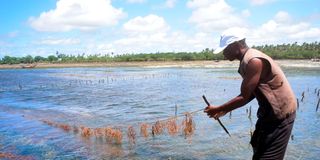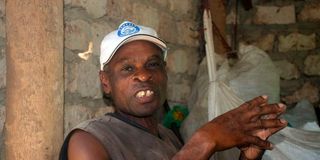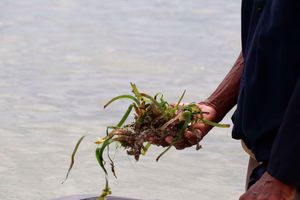Conserving seagrass: The unsung hero of marine life

Shangani Amani Self Help Group Chairman Bakari Ali at their seaweed farm in Msambweni, Kwale Coun
What you need to know:
- These vital ecosystems are under threat, their decline driven by plastic and sewage pollution, overfishing, coastal development, unregulated boat anchoring and sand harvesting.
In the quiet coastal waters of Msambweni, Kwale County, a group of local fishermen is spearheading grassroots efforts to protect the ocean that sustains their livelihoods.
At the core of their mission is seagrass, an unsung hero of the marine world.
To many, seagrass may seem unremarkable, overshadowed by the glamour of coral reefs or the majesty of mangrove forests. But to fishermen like Bakari Ali, these underwater meadows are nothing short of essential.
Also read: Fishing, pollution threaten crucial seagrass
The underwater plants are silent powerhouses, sustaining marine life, stabilising coastlines, and fighting climate change.

Bakari Ali from Msambweni in Kwale County emphasised the importance of seagrass as breeding grounds for fish.
Bakari emphasises the importance of seagrass as breeding grounds for fish.
“These meadows are breeding grounds for fish. Here, we are lucky to have healthy seagrass beds, and they are the reason our fisheries survive,” says the chairman of Shangani Amani Self-help Group, a local organisation championing sustainable fisheries and ocean conservation.
Bakari notes that seagrasses are a central focus because of their direct impact on marine biodiversity, food security, and climate resilience.
“When seagrasses disappear, fish disappear. And when fish disappear, our families suffer,” he says, adding: “The health of our ocean is the health of our people.”
Shangani Group, which has over 30 members, engages in various conservation activities, including mangrove restoration, plastic waste clean-ups and promoting seaweed farming as an eco-friendly livelihood.
Through regular beach clean-ups, the group collects plastic waste littering the coastline. They have also partnered with local recycling initiatives to turn the trash into treasure.
“We repurpose plastic into planting vessels for mangrove seedlings,” Bakari explains. “It reduces waste and supports our mangrove nurseries.” The group has cultivated over 150,000 mangrove seedlings.
Apart from helping stabilise shorelines and filter water, the seedlings are also generating income for the group members.
“We sell the seedlings and use the money to support our projects,” Bakari says. “Some of it goes into a loan system, where members can borrow up to Sh20,000.”
From seaweed farming, which deters illegal fishing while boosting fish populations, to discussions about launching Kenya’s first community-led seagrass planting initiative, the group’s vision for marine restoration is expansive.
“We want to start planting seagrass,” says Bakari. “We haven’t begun yet, but we’re seeking training and knowledge to make it possible.”
Seagrass meadows cover less than 0.1 per cent of the ocean floor, yet their impact is vast. According to Kevin Lunzalu, a marine ecologist with the East African Wildlife Society, seagrasses are one of the most efficient carbon sinks on earth. “They store up to 35 times more carbon than land forests,” he explains.
“They are critical in mitigating climate change.”
But climate change is just one part of the equation. Seagrasses also filter pollutants, stabilise sediments, support fish and sea turtle populations, and protect coastlines from erosion.
“They are nature’s filtration and defence systems,” says Lunzalu. “They bind the seabed with their roots and reduce wave energy, protecting coastal communities.”
But these ecosystems are under threat. A 2018 report by the Wildlife Conservation Society revealed that Kenya’s seagrass coverage was approximately 31,710 hectares, but shrinking by 1.69 per cent annually. This decline is driven by multiple stressors: plastic and sewage pollution, overfishing, coastal development, unregulated boat anchoring, and sand harvesting.
“Seagrasses can’t survive without clean water and stable conditions,” Lunzalu says. “Pollutants block sunlight, sediments smother them, and rising ocean temperatures due to climate change are weakening their ability to regenerate.”
But despite the challenges, there is optimism.
Fishing regulations
Kenya has joined international pledges to conserve 30 per cent of its land and marine ecosystems by 2030, and seagrass restoration is seen as a key tool in reaching that goal.
At the forefront
But for any meaningful restoration to succeed, Lunzalu says, local communities must be at the forefront.
“Locally Managed Marine Areas have been very effective,” Lunzalu explains. “They empower communities to protect their waters, enforce fishing regulations, and preserve marine biodiversity.”
He advocates for an integrated approach that brings together government, civil society, private industry, and local groups.
“Seagrass conservation needs to be part of our tourism and fisheries strategies.
“Industries that benefit from healthy oceans must also contribute to their protection.”
Shangani Amani Self-help Group is already setting an example. Through their efforts, they’re not only cleaning the ocean but creating the conditions that allow seagrasses to thrive.
“Clean water lets sunlight reach the ocean floor, which is crucial for seagrass photosynthesis,” Lunzalu notes. “Removing debris prevents physical damage, and planting mangroves reduces erosion and traps sediments.”
Mangroves and seagrasses form interconnected ecosystems. “When mangroves thrive, they filter nutrients and stabilise coastlines, creating ideal conditions for seagrass to grow. And when seagrass flourishes, fish populations increase, carbon is captured, and biodiversity rebounds,”explains Lunzalu.
Bakari says they are already seeing positive changes. “The area where we farm seaweed is now attracting more fish. The environment is recovering.”
But there is still a long way to go as Bakari admits that challenges exist. “We know how important seagrasses are, but we don’t yet have the training or resources to plant them. We need support — technical, financial, and educational.”
He hopes that with backing from conservation groups, government agencies, and donors, their group can become a model for community-led seagrass restoration in East Africa.
“And as the tide of climate change and pollution rises, we hope that our grassroots efforts may just be what turns the tide back in nature’s favour.”


